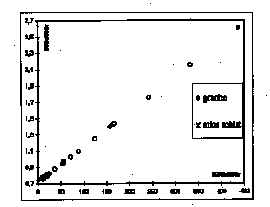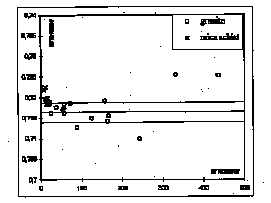
Several publications are dealing with the dating of the Li-F granite intrusion and related tin deposits from Ehrenfriedersdorf, Central Erzgebirge (Belyatsky & Kempe, 1994; Gerstenberger et al., 1995; Seifert, 1994). In this work, 21 samples of mica schists and granitic rocks including two thin-slab-profiles (granite/schist contact - 7 slabs and aplite/schist contact - 4 slabs) were investigated by Rb-Sr WR method, chemical and microprobe analysis.
Both granitic and wall rocks show more or less strong metasomatic alterations. Granitic rock samples lie on a
well defined line in the isochron diagram (apparent age 303.7 ± 1.3 Ma, MSWD = 1.21, Fig. 1).
It should be stressed here, that all samples of mica schists lie on or very close to the "isochron" in the lower left part of the isochron diagram. This may be an indication for mixing processes in this case.
Using usual criteria, there is no evidence for simple two source mixing (no correlation between Rb vs. Sr content as well as no correlation between 87Sr/86Sr vs. 1/Sr). Nevertheless, certain samples of granitic rocks form a straight line in the 87Sr/86Sr vs. 1/Sr diagram. Stepwise recalculation of 87Sr/86Sr ratios up to the "isochron" age results in a clockwise rotation of the "isochron" with increasing MSWD. No complete homogenisation of 87Sr/86Sr isotope ratios can be observed at 303.7 Ma (Fig. 2) which fact indicates distortion of starting condition.
We assume that the crustal signature of the granitic
rocks (initial 87Sr/86Sr = 0.7165) is due to assimilation of
Sr-rich mica schists (~ 50 ppm) by low Sr-granitic magma (9-16 ppm) leading to heterogeneity in initial 87Sr/86Sr ratios. This hypothesis is supported by Rb-Sr model ages decreasing continuously from 480 Ma in the mica schists down to 307 Ma in the granite. Metasomatic alteration of the rocks by P-, B- and F- bearing fluids leads to the introduction of high Rb contents into the system. Resulting high Rb/Sr ratios can "overwhelm" initial 87Sr/86Sr heterogeneity (Hoffmann, 1993).
The straight line in the isochron diagram is therefore caused by interaction of three sources: the granitic magma, metasomatic fluids and the wall rocks. Possible, the "isochron age" reflects nearly the metasomatic event which not necessary differs significantly from the intrusion age of the granite.
Belyatsky, B.V. & Kempe, U., 9th IAGOD symp., abs. 1, 333-336 (Chinese Aca. Sc., Beijing, 1994).
Gerstenberger, H., Haase, G. & Wemmer, K., Terra Nostra 7, 36-41 (1995).
Hoffmann, A. W., Rad. Age Determ. in Orog. Proc., 53-65 (Earth planet. Sci. Lett., Siena, 1993).
Seifert, Th., Eur. J. Mineral. 6, Bh. 1, 260 (1994).
Fig. 1: Isochron diagram for all samples investigated including schists and slabs.
Fig. 2: Recalculated 87Sr/86Sr ratios in relation to initial ratio (2 sigma interval) at 303.7 Ma.